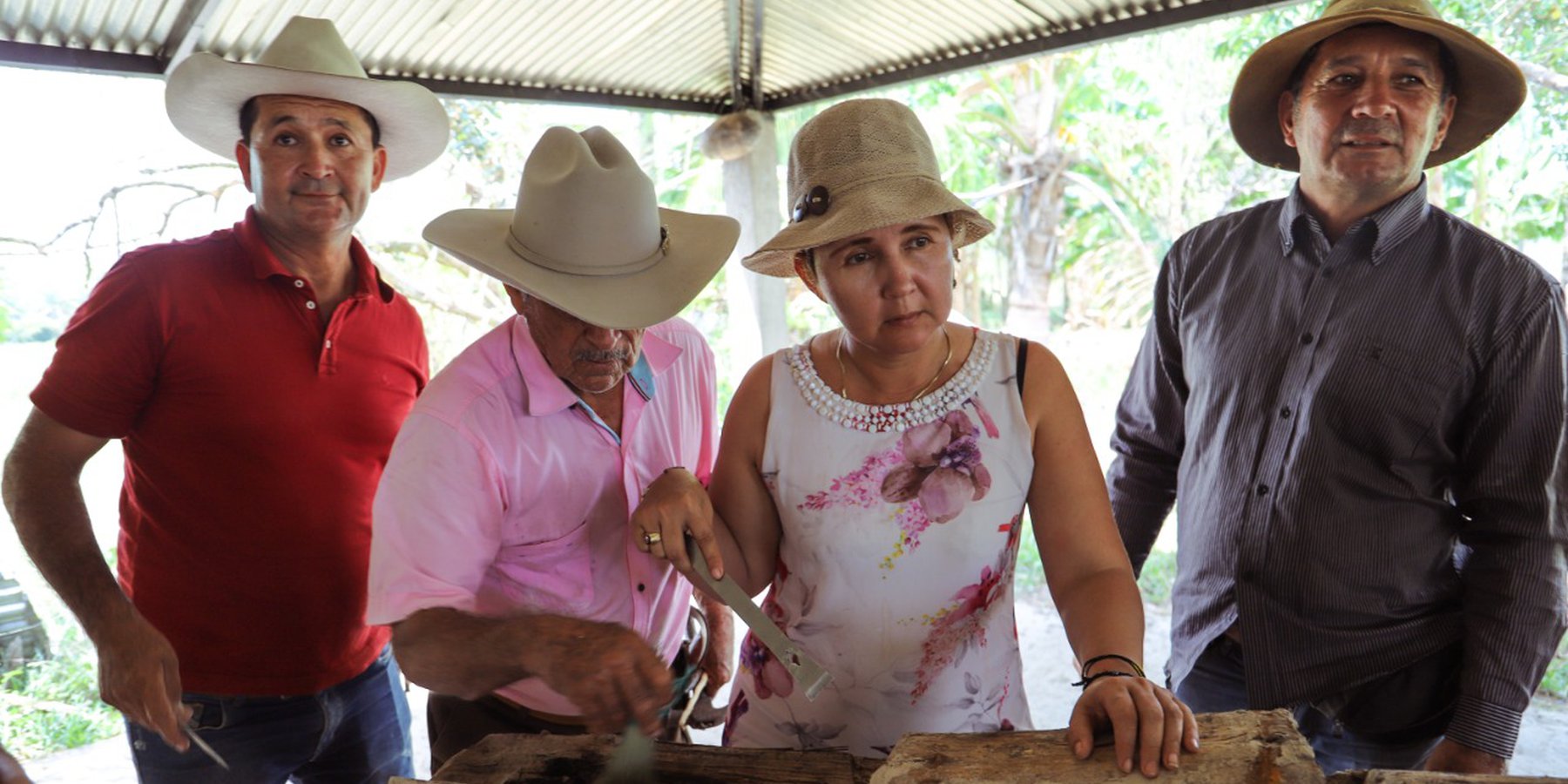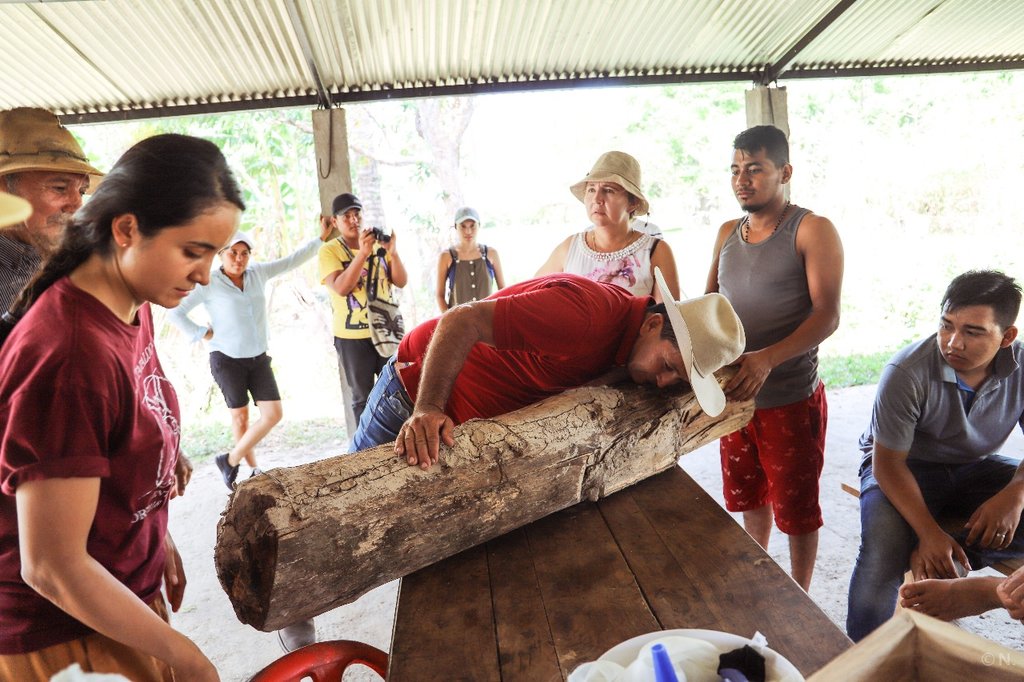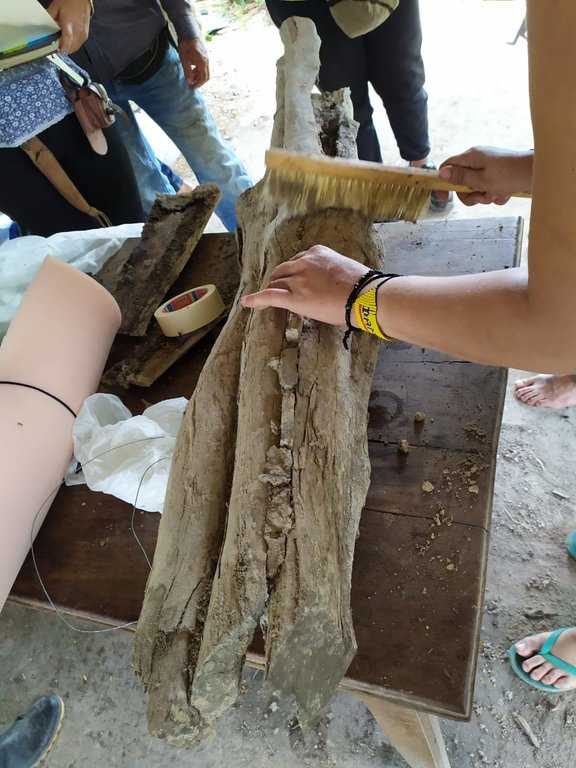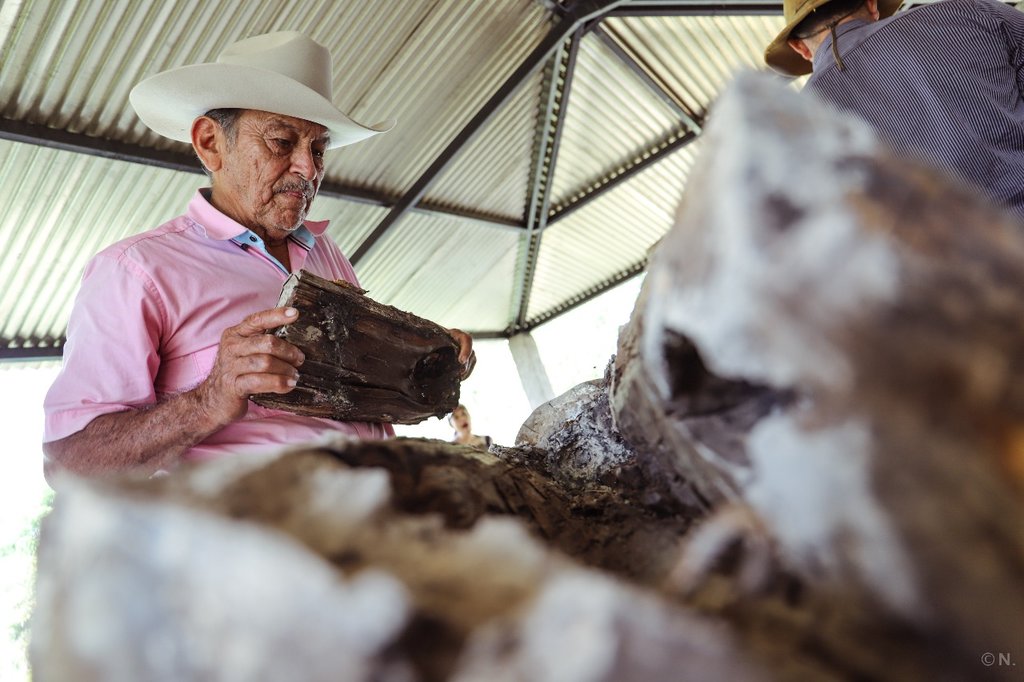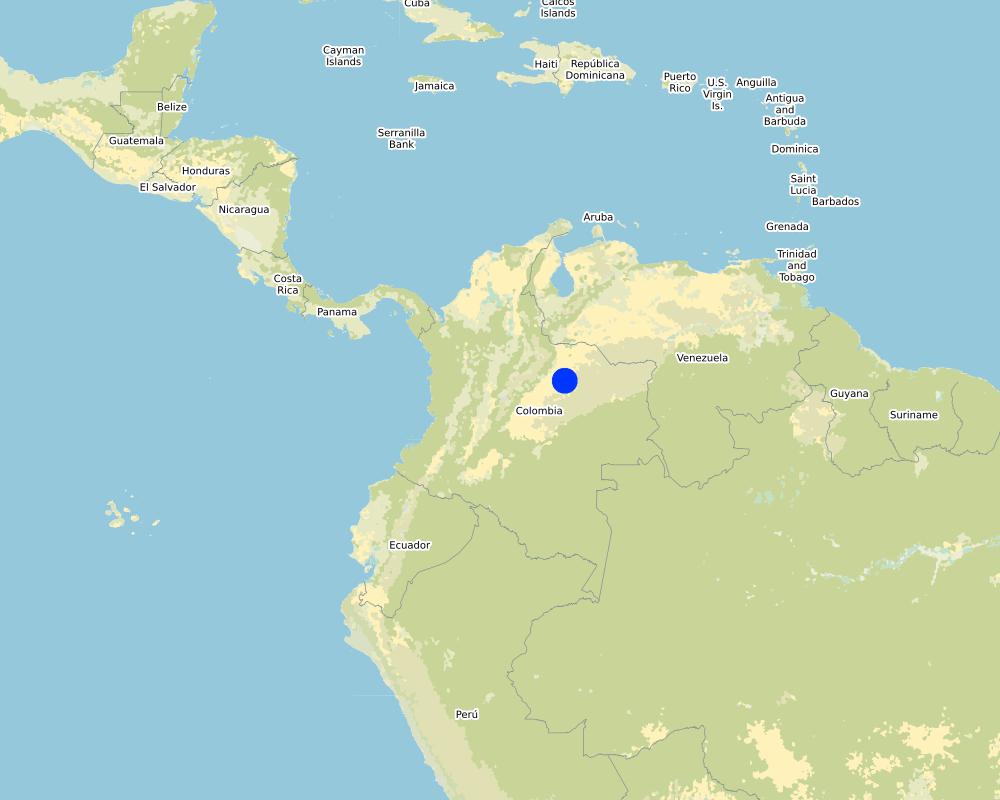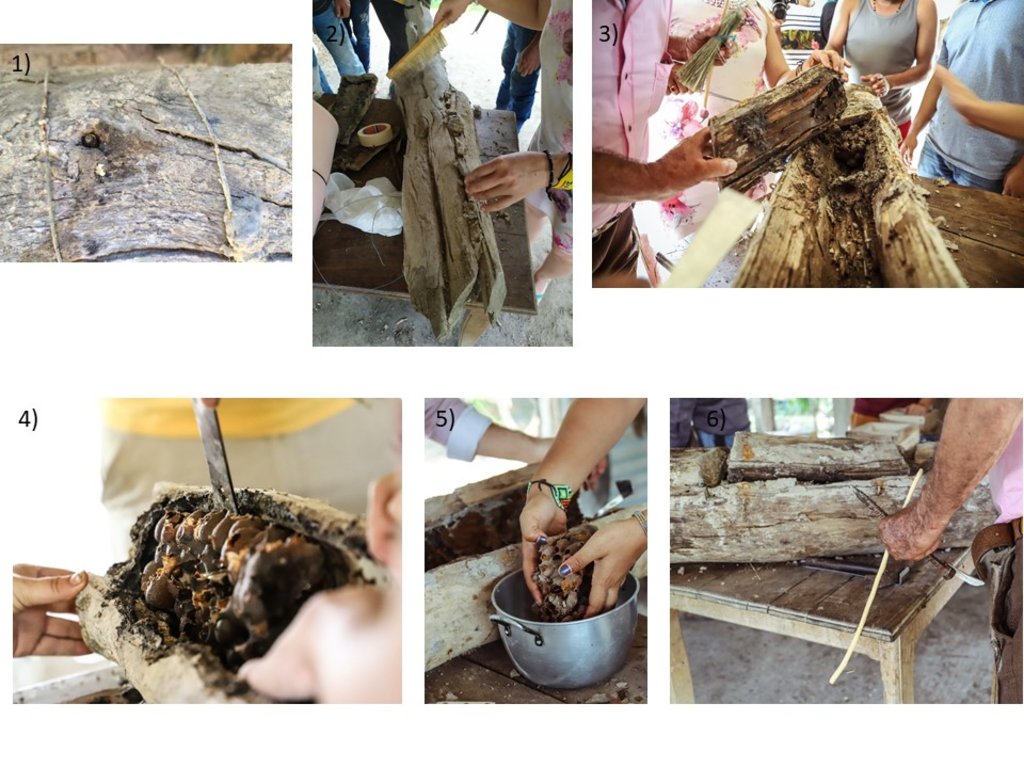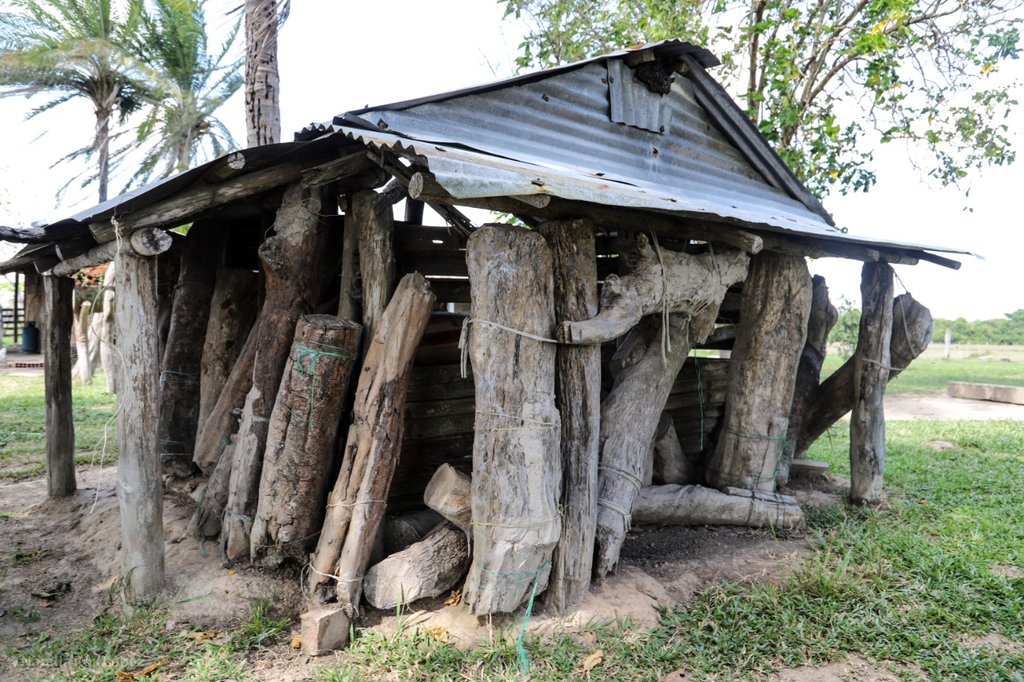Sustainable traditional native bee (Melipona favosa) keeping [Colombia]
- Creation:
- Update:
- Compiler: Beatriz Ramirez
- Editor: Luisa F. Vega
- Reviewer: Hanspeter Liniger
Cría de abeja mancita
technologies_5797 - Colombia
View sections
Expand all Collapse all1. General information
1.2 Contact details of resource persons and institutions involved in the assessment and documentation of the Technology
Key resource person(s)
land user:
Abril Héctor
Finca La Reforma
Colombia
land user:
Abril Héctor Frugo
Finca La Corocora
Colombia
land user:
Abril Damaris
Finca La Esmeralda
Colombia
land user:
Abril Boncieth
Finca Arbolitos
Colombia
land user:
Abril Héctor Daniel
Finca La Berraquera
Colombia
Name of the institution(s) which facilitated the documentation/ evaluation of the Technology (if relevant)
Centro de Estudios Ambientales de la Orinoquia- Asociación de Becarios de Casanare (ABC) - Colombia1.3 Conditions regarding the use of data documented through WOCAT
The compiler and key resource person(s) accept the conditions regarding the use of data documented through WOCAT:
Ja
1.4 Declaration on sustainability of the described Technology
Is the Technology described here problematic with regard to land degradation, so that it cannot be declared a sustainable land management technology?
Nee
2. Description of the SLM Technology
2.1 Short description of the Technology
Definition of the Technology:
Native stingless bee keeping (Melipona favosa) protects bees and plants found in forest and savannah ecosystems to produce honey. In contrast to current destructive wild bee honey harvesting, members of the Abril family keep the traditional practice of capturing/rescuing wild nests, and adapt them so that honey can be extracted from the same nest for many years (up to 30 y) without killing the bees.
2.2 Detailed description of the Technology
Description:
Native bee honey production in the floodable savannahs of the eastern Colombian Llanos (Orinoco River Basin), relies on stingless bees of the species Melipona favosa. These bees nest inside tree trunks. The main characteristics of the native bee keeping, as currently performed by three generations of the Abril Family, is that it is sustainable, promotes de conservation of native ecosystems, and as far as we know, constitutes the only sustainable and profitable direct use of local biodiversity in the floodable savannahs of the eastern Llanos in Colombia. Its sustainability is due to the adaptations and management of the nests, so that honey can be extracted without damaging the bees. On one hand, they know how to retrieve wild nests, either by rescuing them from rotten trees or the ground, or by cutting the branch with the nest, and then keeping its natural position at all times. Once at their houses, they will study the outside of the nest and listen to the bees inside the nest, with this information they will cut out a part of the tree trunk to create a window. Once opened, they verify the location of the honey and pollen pots and the broods. Then, they will reattach the cut part on to the trunk by using metal wire and sealing the edges with mud. The nest will be hanged with wire in the position it was originally found. Once on site they will check every day for the presence of the sentinel bee and bee activity. Furthermore, they only extract honey during the end of the dry season when bees have enough food reserves. For the extraction, they will reopen the previously cut window, and extract the honey and pollen pots, making sure enough are left behind so that bees can have access to food as well. The mean honey production from each nest is around the 750 ml- 1000 ml. Honey is kept for their own use and sold to some people for a fairly high price (30 dollars per 750 ml). The honey is mainly consumed as a medicinal product, and its low quantity makes it highly sought after. If someone requests it for sight issues, Héctor will extract the honey with a syringe so that it is as clear as possible.
The native bee keeping contributes to protect native bees, as the management of nests can keep them functional for up to 30 years. The Abril family members are well aware of the dependency between honey production and presence of native plants from where bees forage for nectar and pollen. Therefore, they avoid forest clearing and selectively keep shrubs in the grasslands to guarantee food supply for their bees. Also, they plant fruit trees such as guayaba (Psidium guajava) and arazá (Eugenia stipitata), that benefit the bees, which at the same time benefit pollination. Fruit production is mainly used for home use and very seldom they are sold. They also witness the negative impacts that agrochemical airborne dispersion from rice production in the neighbouring farms, have on wild bee populations. So far, their main concern is that they do not know how to multiply the nests.
2.3 Photos of the Technology
2.4 Videos of the Technology
Comments, short description:
They are harvesting the honey from the pots throught the window, without affecting the brooding area. https://youtu.be/ZS_TbwV3fnw
Date:
30/01/2020
Location:
Finca La Reforma, Vereda Los chochos, Municipality: Trinidad, Department: Casanare, Colombia
Name of videographer:
Mildred Sossa
2.5 Country/ region/ locations where the Technology has been applied and which are covered by this assessment
Country:
Colombia
Region/ State/ Province:
Casanare
Further specification of location:
Municipality: Trinidad, Vereda: Los Chochos
Specify the spread of the Technology:
- applied at specific points/ concentrated on a small area
Is/are the technology site(s) located in a permanently protected area?
Nee
Comments:
All farms are neighbors and they all belong to the Abril family members (Father, two sons and a daughter)
Map
×2.6 Date of implementation
If precise year is not known, indicate approximate date:
- 10-50 years ago
2.7 Introduction of the Technology
Specify how the Technology was introduced:
- as part of a traditional system (> 50 years)
Comments (type of project, etc.):
Héctor Abril, has been working with this traditional systems since more than 50 years ago. The traditional system consists in creating a window implied o extract honey without damaging the nest. This knowledge has been passed on to his sons and daughter.
3. Classification of the SLM Technology
3.1 Main purpose(s) of the Technology
- improve production
- conserve ecosystem
- preserve/ improve biodiversity
- create beneficial economic impact
3.2 Current land use type(s) where the Technology is applied
Land use mixed within the same land unit:
Nee

Grazing land
Extensive grazing:
- Ranching
Animal type:
- cattle - non-dairy beef
Is integrated crop-livestock management practiced?
Nee
Products and services:
- meat
Species:
cattle - non-dairy beef
Count:
150
Species:
beekeeping, apiculture
Count:
80

Forest/ woodlands
- (Semi-)natural forests/ woodlands
(Semi-)natural forests/ woodlands: Specify management type:
- Selective felling
- Non-wood forest use
Type of (semi-)natural forest:
- tropical moist deciduous forest natural vegetation
- tropical shrubland natural vegetation
- Natural strips of gallery forest along savannah's rivers
Comments:
The main economic activity of this group of farms is extensive cattle ranching on natural floodable savannhas (242 ha), but they all have bee keeping in their houses. The number 80 refers to the nest quantity. They preserve gallery forests (108 ha) and allow for fallows (28 ha) to develope near the houses for supplying nectar and pollen to the bees.
3.3 Has land use changed due to the implementation of the Technology?
Has land use changed due to the implementation of the Technology?
- Yes (Please fill out the questions below with regard to the land use before implementation of the Technology)
Land use mixed within the same land unit:
Nee

Forest/ woodlands
- (Semi-)natural forests/ woodlands
(Semi-)natural forests/ woodlands: Specify management type:
- Non-wood forest use
Type of (semi-)natural forest:
- tropical moist deciduous forest natural vegetation
- tropical shrubland natural vegetation
Comments:
The fact that their traditional practice allow for them to keep the bee nests in their houses for up to 30 years, means that they had to protect surrounding forests and allow for shrubland recovery nearby the house. Otherwise, they would just either collect honey directly in the field in a single destructive event or bring a couple of nests per year home and then extract honey in a destructive way.
3.4 Water supply
Water supply for the land on which the Technology is applied:
- rainfed
Comments:
The farms have some windmills for water extraction for the cattle ranching, but these are not used for the natural ecosystems that sustain the bees during the dry season.
3.5 SLM group to which the Technology belongs
- beekeeping, aquaculture, poultry, rabbit farming, silkworm farming, etc.
3.6 SLM measures comprising the Technology

vegetative measures
- V1: Tree and shrub cover

management measures
- M1: Change of land use type
Comments:
Bee keeping implies supplying the bees nectar and polen demands, thus, for sustaining their bees the Abril family is particularly keen on protecting their gallery forests and allow shrub regeneration. In addition, they are cultivating fruit trees (guayaba- Psidium guajava; arazá- Eugenia stipitata) near the houses, impplying a change in land cover from grazing land to fruit crops.
3.7 Main types of land degradation addressed by the Technology

soil erosion by water
- Wt: loss of topsoil/ surface erosion

soil erosion by wind
- Et: loss of topsoil

physical soil deterioration
- Pc: compaction

biological degradation
- Bh: loss of habitats
- Bs: quality and species composition/ diversity decline
Comments:
Forest conservation and shrub recovery and fruit crops aid in the reduction of erosion by water during the wet season, and erosion by wind during the dry season. Forest conservation and shrub recovery and fruit crops reduce areas exposed to cattle trampling. Forest conservation, shrub recovery and fruit crops are likely important to protect soil fauna, to enhance the survival of bees and many other animal and plant species. A high density of pollinators is also important for natural vegetation and fruitting crop
3.8 Prevention, reduction, or restoration of land degradation
Specify the goal of the Technology with regard to land degradation:
- prevent land degradation
Comments:
On the one hand, they actively preserve the riparian forests because of their awareness of the relation between bee survival and honey production with forest cover. This reduces land degradation. On the other hand, surrounding their houses where they keep the bees they have planted trees and allowed for fallow areas to offer pollen and nectar to their bees, restoring land that has been previously used for cattle ranching
4. Technical specifications, implementation activities, inputs, and costs
4.1 Technical drawing of the Technology
Technical specifications (related to technical drawing):
This is too complex to draw, so we presented the sequence of extracting honey in a nest that has been modified so that the nest can live up to 30 years.
Author:
Natalia Roa y Beatriz Ramírez
Date:
30/01/2020
Technical specifications (related to technical drawing):
This is the housing for the nests. These nests have been collected or rescued from field. The youngest has 3 years the oldest has around 30 years. It is very important to keep the nests in the position they were originally found. The housing is to prevent direct sunshine and rainfall exposition.
Author:
Natalia Roa
Date:
30/01/2020
4.2 General information regarding the calculation of inputs and costs
Specify how costs and inputs were calculated:
- per Technology unit
Specify unit:
bee nest
Specify currency used for cost calculations:
- USD
Indicate average wage cost of hired labour per day:
$ 15
4.3 Establishment activities
| Activity | Timing (season) | |
|---|---|---|
| 1. | Wild nest recue or extraction and transport to the house | Depends on the finding, but it is preferred in the dry season where more floral resources are available |
| 2. | Opening of a window in the nest | A couple of days after being collected/recued |
| 3. | Locating the nest under housing | Just after the window opening |
4.4 Costs and inputs needed for establishment
| Specify input | Unit | Quantity | Costs per Unit | Total costs per input | % of costs borne by land users | |
|---|---|---|---|---|---|---|
| Labour | Two people for wild nest recue or extraction and transport to the house | day | 2.0 | 15.0 | 30.0 | 100.0 |
| Labour | Opening of a window in the nest | day | 0.5 | 15.0 | 7.5 | 100.0 |
| Labour | Housing construction (two people) | day | 2.0 | 15.0 | 30.0 | 100.0 |
| Labour | 100.0 | |||||
| Equipment | Saw | unit | 1.0 | 20.0 | 20.0 | 100.0 |
| Equipment | Chissel | unit | 1.0 | 10.0 | 10.0 | 100.0 |
| Equipment | hammer | unit | 1.0 | 8.0 | 8.0 | 100.0 |
| Equipment | Metal wire | kilo | 0.5 | 11.0 | 5.5 | 100.0 |
| Equipment | Ax | unit | 1.0 | 20.0 | 20.0 | 100.0 |
| Construction material | boles minimum 15 cm diamater and 2 m of height | boles | 4.0 | 8.0 | 32.0 | 100.0 |
| Construction material | wood support 4 m long | unit | 4.0 | 6.0 | 24.0 | 100.0 |
| Construction material | Roof laminas (3 m) | laminas | 3.0 | 18.0 | 54.0 | 100.0 |
| Construction material | Nails | box | 2.0 | 9.0 | 18.0 | 100.0 |
| Total costs for establishment of the Technology | 259.0 | |||||
| Total costs for establishment of the Technology in USD | 259.0 | |||||
Comments:
The construction of a bee nest house can hold up to 30 bee nests.
4.5 Maintenance/ recurrent activities
| Activity | Timing/ frequency | |
|---|---|---|
| 1. | Checking the bee nests | daily |
| 2. | Harvesting honey | yearly |
| 3. | Seedling collection | monthly |
| 4. | tree nursery care | daily |
| 5. | planting trees | monthly |
4.6 Costs and inputs needed for maintenance/ recurrent activities (per year)
| Specify input | Unit | Quantity | Costs per Unit | Total costs per input | % of costs borne by land users | |
|---|---|---|---|---|---|---|
| Labour | Daily check per bee nest | day | 0.005 | 15.0 | 0.07 | 100.0 |
| Labour | honey harvest per bee nest (2 people) | day | 1.0 | 15.0 | 15.0 | 100.0 |
| Labour | Seedling collection | month | 2.0 | 15.0 | 30.0 | 100.0 |
| Labour | Planting of fruitting trees | month | 2.0 | 15.0 | 30.0 | 100.0 |
| Equipment | Chissel | unit | 1.0 | 10.0 | 10.0 | 100.0 |
| Equipment | Broom | unit | 1.0 | 3.0 | 3.0 | 100.0 |
| Equipment | Hammer | unit | 1.0 | 8.0 | 8.0 | 100.0 |
| Equipment | Syringe | unit | 1.0 | 0.2 | 0.2 | 100.0 |
| Equipment | Empty glass bottles (750 ml) | unit | 70.0 | 0.4 | 28.0 | 100.0 |
| Equipment | Table | unit | 1.0 | 30.0 | 30.0 | 100.0 |
| Equipment | shovel | unit | 1.0 | 20.0 | 20.0 | 100.0 |
| Plant material | Bags x 50 units | bag | 1.0 | 5.0 | 5.0 | 100.0 |
| Plant material | Soil | sack | 4.0 | 6.0 | 24.0 | 100.0 |
| Total costs for maintenance of the Technology | 203.27 | |||||
| Total costs for maintenance of the Technology in USD | 203.27 | |||||
4.7 Most important factors affecting the costs
Describe the most determinate factors affecting the costs:
The way they manage the bee productive system is fairly cheap and most materials are already accessible within the farms.
5. Natural and human environment
5.1 Climate
Annual rainfall
- < 250 mm
- 251-500 mm
- 501-750 mm
- 751-1,000 mm
- 1,001-1,500 mm
- 1,501-2,000 mm
- 2,001-3,000 mm
- 3,001-4,000 mm
- > 4,000 mm
Specify average annual rainfall (if known), in mm:
1938.00
Specifications/ comments on rainfall:
highly monomodal seasonal rainfall with 4 months without rainfall (< 60 mm/ month), and 8 months with rainfall (>100 mm/ month) with June as the month with highest rainfall (> 300 mm)
Indicate the name of the reference meteorological station considered:
Estación pluviométrica de Trinidad (IDEAM)
Agro-climatic zone
- sub-humid
The highly seasonal rainfall, implies four months of extreme drought and at least 6 months of flooded areas. Both severely limit crop growth.
5.2 Topography
Slopes on average:
- flat (0-2%)
- gentle (3-5%)
- moderate (6-10%)
- rolling (11-15%)
- hilly (16-30%)
- steep (31-60%)
- very steep (>60%)
Landforms:
- plateau/plains
- ridges
- mountain slopes
- hill slopes
- footslopes
- valley floors
Altitudinal zone:
- 0-100 m a.s.l.
- 101-500 m a.s.l.
- 501-1,000 m a.s.l.
- 1,001-1,500 m a.s.l.
- 1,501-2,000 m a.s.l.
- 2,001-2,500 m a.s.l.
- 2,501-3,000 m a.s.l.
- 3,001-4,000 m a.s.l.
- > 4,000 m a.s.l.
Indicate if the Technology is specifically applied in:
- not relevant
Comments and further specifications on topography:
This is a low elevation flat area. Overall the floodable savannahs are concave but microtopography has primarily concave areas (bajos) with a lower extent of convex areas (bancos).
5.3 Soils
Soil depth on average:
- very shallow (0-20 cm)
- shallow (21-50 cm)
- moderately deep (51-80 cm)
- deep (81-120 cm)
- very deep (> 120 cm)
Soil texture (topsoil):
- medium (loamy, silty)
Soil texture (> 20 cm below surface):
- medium (loamy, silty)
- fine/ heavy (clay)
Topsoil organic matter:
- low (<1%)
If available, attach full soil description or specify the available information, e.g. soil type, soil PH/ acidity, Cation Exchange Capacity, nitrogen, salinity etc.
In the seasonally floodable savannhas there are three main soil types: 1) Clayey sediments, 2) fine and coarse alluvial sediments, and 3) lime and sand eolic deposits. Soil description is based on the 1:100.000 scale Casanare soil study, by the National Geographical Institute Agustín Codazzi.
5.4 Water availability and quality
Availability of surface water:
medium
Water quality (untreated):
poor drinking water (treatment required)
Is water salinity a problem?
Nee
Is flooding of the area occurring?
Ja
Regularity:
frequently
Comments and further specifications on water quality and quantity:
Drinking water is usually provided by ground water year round. During the wet season there is a generalized flood, and during the dry season there is severe drought. Thus, the water table level goes from surface to deeper than 9 m.
5.5 Biodiversity
Species diversity:
- high
Habitat diversity:
- high
Comments and further specifications on biodiversity:
Habitats include: Gallery/riparian forest, isolated tree islands (matas de monte), seasonally flooded savannhas, wetlands.
Reported biodiversity for the seasonally floodable savannahs is: 183 spp of mammals, 507 spp of birds, 108 spp of anphibians, 119 spp of reptiles, 567 spp of fish, 1479 spp of plants (Mora-Fernández et al., 2015).
5.6 Characteristics of land users applying the Technology
Sedentary or nomadic:
- Sedentary
Market orientation of production system:
- mixed (subsistence/ commercial)
Off-farm income:
- less than 10% of all income
Relative level of wealth:
- poor
Individuals or groups:
- individual/ household
Level of mechanization:
- manual work
- animal traction
Gender:
- women
- men
Age of land users:
- middle-aged
- elderly
Indicate other relevant characteristics of the land users:
All the land user's reported here are family members.
5.7 Average area of land used by land users applying the Technology
- < 0.5 ha
- 0.5-1 ha
- 1-2 ha
- 2-5 ha
- 5-15 ha
- 15-50 ha
- 50-100 ha
- 100-500 ha
- 500-1,000 ha
- 1,000-10,000 ha
- > 10,000 ha
Is this considered small-, medium- or large-scale (referring to local context)?
- small-scale
- medium-scale
Comments:
For the area 30 ha farms are very small, whereas 200 ha is small-medium. This is considering that farms in this region of colombia have on average 700 ha.
5.8 Land ownership, land use rights, and water use rights
Land ownership:
- individual, not titled
Land use rights:
- individual
Water use rights:
- individual
Are land use rights based on a traditional legal system?
Ja
Specify:
They are in the process of gaining rights, given the farms have been theirs for more than 50 years.
5.9 Access to services and infrastructure
health:
- poor
- moderate
- good
education:
- poor
- moderate
- good
technical assistance:
- poor
- moderate
- good
employment (e.g. off-farm):
- poor
- moderate
- good
markets:
- poor
- moderate
- good
energy:
- poor
- moderate
- good
roads and transport:
- poor
- moderate
- good
drinking water and sanitation:
- poor
- moderate
- good
financial services:
- poor
- moderate
- good
Comments:
These farms are in fairly remote area with poor access roads, there is a rural school but for the other services people have to travel for at least 2 hours by car to the closest urban center.
6. Impacts and concluding statements
6.1 On-site impacts the Technology has shown
Socio-economic impacts
Production
non-wood forest production
Comments/ specify:
Honey harvesting from collected bee nests
Income and costs
farm income
Comments/ specify:
Honey harvesting contributes with about 10% of farm income
diversity of income sources
Comments/ specify:
Honey harvesting is an additional income source from cattle ranching
Socio-cultural impacts
food security/ self-sufficiency
Comments/ specify:
Part of the honey and most of the fruits harvested are consumed by the land user theirself.
Ecological impacts
Biodiversity: vegetation, animals
beneficial species
Comments/ specify:
The preservation of bee nests increases pollinator presence, whilst the conservation of gallery forests preserves habitats for wild bee populations.
habitat diversity
Comments/ specify:
allowing for fallows to regenerate for providing bees with resources (nectar, pollen, resins and seeds) increase habitat diversity.
Specify assessment of on-site impacts (measurements):
Measurements are qualitative estimates
6.2 Off-site impacts the Technology has shown
buffering/ filtering capacity
Comments/ specify:
Riparian forest conservation contributed to water regulation
Specify assessment of off-site impacts (measurements):
Measurements are qualitative estimates
6.3 Exposure and sensitivity of the Technology to gradual climate change and climate-related extremes/ disasters (as perceived by land users)
Climate-related extremes (disasters)
Biological disasters
| How does the Technology cope with it? | |
|---|---|
| epidemic diseases | not well |
6.4 Cost-benefit analysis
How do the benefits compare with the establishment costs (from land users’ perspective)?
Short-term returns:
slightly positive
Long-term returns:
very positive
How do the benefits compare with the maintenance/ recurrent costs (from land users' perspective)?
Short-term returns:
slightly positive
Long-term returns:
very positive
Comments:
Honey harvesting is only possible once per year so for the short term it takes some time before retrieving income. However, once the nests are re-established at home the maintenance is fairly easy. The rareness and uniqueness of the product sells well in the local market. The external markets are not aware of such a product.
6.5 Adoption of the Technology
- single cases/ experimental
If available, quantify (no. of households and/ or area covered):
5
Of all those who have adopted the Technology, how many did so spontaneously, i.e. without receiving any material incentives/ payments?
- 91-100%
Comments:
Talking with other local people we found that the traditional practice is very rare, mainly because it used to be the only source for sweeteners, but with the arrival of sugar cane and sugar, people stopped the practice, and for new generations the tradicional way is almost forgotten. This is highly menacing because when people find a wild nest they only destructively extract the honey affecting wild bee populations.
6.6 Adaptation
Has the Technology been modified recently to adapt to changing conditions?
Nee
6.7 Strengths/ advantages/ opportunities of the Technology
| Strengths/ advantages/ opportunities in the land user’s view |
|---|
| The medicinal properties attributed to the product make it highly sought after. |
| Having the nests at home, and passing on the traditional practice to new generations is very important, because they find very interesting to know about bee behaviour and pollination function for fruitting trees. |
| Costs are fairly low, and despite production is synchronized the demand of the product is higher that the production, so it is a welcome income to the family household assets. |
| Strengths/ advantages/ opportunities in the compiler’s or other key resource person’s view |
|---|
| Their practice is non destructive and bee population is enhanced in the houses, it is very likely that bees will find new wild nesting sites. In this regard bee nests at houses are a source of individuals for wild populations, given that there are trees and forests nearby. |
| This practice and their knwoledge on bee behaviour and biology motivates people to conserve forests and trees and allow for fallows surrounding their houses. |
| Negative effects on their bee populations derived from land use change int heir surroundings and application of agrochemicals by neighboring rice crops serve as an indicator for them to know if those practices are deteriorating their environment. |
6.8 Weaknesses/ disadvantages/ risks of the Technology and ways of overcoming them
| Weaknesses/ disadvantages/ risks in the land user’s view | How can they be overcome? |
|---|---|
| Despite the long term survival of captured wil bee nests, they still rely on collecting wild nests. Which in time they feel are more scarcee | For them it is crucial to learn how to split their "domesticated" nests so they can increase production without depending on wild nests. |
| The expansion of rice crops in the area is a major threat | Public policy and law inforcement in aerial agrochemical application is urgent. Also, the transition from usual rice crop management to a more enrionmental management is required. |
| New generations are less likely to adopt traditional practices, endengering the persistence of this knowledge in time | The recognition of this traditional productive system is fundamental. |
| Weaknesses/ disadvantages/ risks in the compiler’s or other key resource person’s view | How can they be overcome? |
|---|---|
| A one time per year harvesting of the product could potentially be increased to expand this sustainable practice | Restoration of key dietary elements surrounding their houses and an increase in connectivity with remaingin forest patches could potentially increase honey production |
| We agree that the loss of this practice is inminent if it is not protected as a cultural heritage | Knwoledge transfer to new generations and the recovery of this productive system, once "domesticated" bee nest can be divided or multiplied. |
7. References and links
7.1 Methods/ sources of information
- field visits, field surveys
4
- interviews with land users
4
When were the data compiled (in the field)?
30/01/2020
Comments:
Land-users were very pleased with the recognition of the their prodcutive systems and were very happy to contribute us to understand how it works.
7.3 Links to relevant online information
Title/ description:
Diversidad de abejas sin aguijón (Hymenoptera: Meliponini) utilizadas en meliponicultura en Colombia. Nates-Parra, G. and Rosso-Londoño, J.M. (2013).
URL:
https://www.redalyc.org/pdf/3190/319029232001.pdf
7.4 General comments
It is a bit too long but feasible to fill in.
Links and modules
Expand all Collapse allLinks
No links
Modules
No modules


